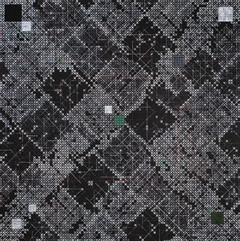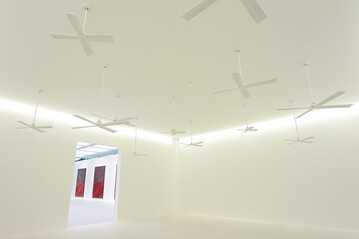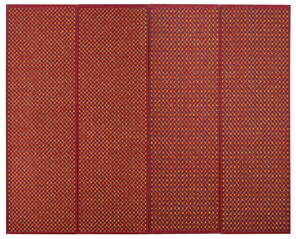Solo Exhibition MOCAUP, Shenzhen, Exhibition Hall: A3
Artists who have left their mark on art history have eyes that look reversely at the values and circumstances of the times. Although these thoughts and attitudes sometimes face adverse effects, they become a motivation to guide artists to a unique new path and provide an important opportunity to differentiate the purpose and value of art. Ding Yi's artistic genes seem to have an anti-aesthetic determination to self-exclude and isolate himself from the existing flow. This may be an important factor that made Ding Yi's art today.
Chinese contemporary art in the 1980s, which the young artist Ding Yi fiercely witnessed and participated in, was an unprecedented experimental dawn in Chinese history. The aesthetic background and color of this period, mostly led by young artists and theorists, was the avant-garde spirit based on radical thinking and differentiation from the past. This stream of consciousness, on the one hand, showed a remarkable artistic practice that was sincere, creative, and mobilized a new imagination. On the other hand, it is also a hybrid period in which ideals and fantasies, retro, surreal and sentimental radical arts erupted together.
Ding Yi took a step back from this overheated scene and was reflecting on the influence of Western contemporary art discourse and style on Chinese contemporary art. On the other hand, he kept a certain distance from the flow of rediscovery or re-view of Chinese traditional culture, which was raised at the same time. In 1988, he finally began to paint small but well-motivated paintings using ×, + in the form of a simple and unattractive lattice. His educational background, where he double majored in art and design, actively contributed to recalling these patterns from his memory.
In a world where everyone pursues and experiments with new things, and newness itself is good, why did Ding Yi choose the old and boring + and lattice patterns as materials that are not new at all? He showed the ability to repeatedly use the obvious material for more than 30 years and change it into something new that is not obvious while making it his own. It proved what sustainable practical aesthetics is. This is why Ding Yi's aesthetics shines, evoking the beauty of insignificant but precious things in a world where meaning and value sweeps away everything.
In the late 1980s, when Ding Yi started abstract art in earnest, the expansion of the discourse on postmodernism was rampant in art history. They were talking about the decline of abstract art, the highlight of modernist art, while calling for the return of the real and the revival of descriptive and figurative things. While prophesying the end of abstract art in the West, a young artist in the eastern part of the world was starting a new abstract art, regardless of the theorists' predictions or fads. Thirty-five years have passed since then, and the young artist has become a pivotal figure in geometric abstraction, marked by aesthetic autonomy. His endurance for art has been forming a hot artery of Ding Yi art, combining tenacity, perseverance, and keen observation.
His 'cross (+) aesthetics' is a social symbol that sometimes makes us read the historical changes of Chinese society, and since the 1990s, it has become a medium of color and form that reflects and expresses industrialization, modernization, and metropolitanization. And it appeared as a comprehensive symbol system that fused painting, design, sculpture, and complex media. It is very rare for a single symbolic pattern acquired in his youth to accompany an artist's entire artistic practice, like Ding Yi's. His art started from the cross symbol and is now heading towards an epic that forms the ‘cross galaxy’ that expresses the universe.
Since his paintings do not intentionally set the center, every corner of the canvas becomes the center. Even in abstract paintings, in most cases, the viewer's eyes are drawn to the center of the painting according to the concentration of the image, color, and illuminance that the artist intends. However, Ding Yi's painting disperses the audience's habitual orientation to the center or desire for concentration. Instead, it makes the audience search for the visual elements they are interested in while studying and looking at the screen. Therefore, the composition of the screen makes the audience find the viewpoints they want somewhere in the surrounding space of the canvas without a center. The pictorial liberation provided by Ding Yi's paintings and the messages guaranteeing and inducing the audience's selective freedom seem to read the artist's message, "Do not look for the meaning of the painting, but look, feel, and contemplate for yourself." In this sense, Ding Yi art is a very social and political message embodying equality.
Ding Yi's paintings contain various messages that allow us to read the changes in the city, environment, and consciousness along with social, epochal, and ecological changes following the evolution of modern science and technology. He composed and expressed the history of the past 30 years, when China's big cities, including his hometown Shanghai, were rapidly changing through various colors, lights, and digital lines. Until the 1990s, dark and black colors appear in paintings depicting his real hometown, Shanghai. However, in the 1990s, sometimes bright fluorescent colors show the feast of light emitted by the industrial society and its speed, and depict the transformation process of the information society and the city through various images reminiscent of QR codes.
This exhibition at the Shenzhen Museum of Contemporary Art and Urban Planning shows another sign of change for Ding Yi. He takes a step away from the all-over painting technique of covering the entire screen with symbols and colors over the past 30 years, and in some of his new works, we can read the changes in the blank space and space of the canvas. In other words, the aesthetic humanism and the beauty of composition liberate the density of composition he was obsessed with, breaking away from the dense spatial composition of the past or the skill level of work, and making the space itself a message. The composition of the freely unfolded painting probably foreshadows a great change that brings more genre liberation in the future, escaping from Ding Yi's painting-centered work attitude.
About the artist
Ding Yi, a pioneer of Chinese abstract painting, works primarily with "+"and its variant as his main visual signals. His works has exhibited extensively at various institutions in global, including The British Museum (London), Power Station of Art (Shanghai), Solomon R. Guggenheim Museum (New York/ Bilbao), Centre Pompidou (Paris). He has held solo exhibitions at various institutions in China and abroad recently, including Long Museum (Shanghai/ Chongqing). Galería RGR (Mexico City), ShanghART Gallery (Shanghai/ Beijing/ Singapore), Galerie KarstenGreve (Cologne/ Paris/ St. Moritz), Guangdong Museum of Art, Timothy Taylor Gallery (New York/ London), Xi’an Art Museum, Hubei Museum of Art, Lhasa Jebum-gang Art Center and Qingdao TAG Art Museum etc.
About the curator
Yongwoo Lee is the professor of the College of Architecture and Urban Planning, Tongji University.He is the founder and artistic director of the Shanghai Project. He was the founding artistic director of the Gwangju Biennale and the president of the Gwangju Biennale Foundation. He served as the director of the Shanghai Himalayas Museum and president of the International Biennial Association. He was a professor at the Shanghai University, Korea University, and a distinguished professor at the Tokyo University of Arts, among others.
Lee curated numerous exhibitions including Times Reimagined (Palazzo Contarini Polignac, collateral eventofthe 59th Venice Biennale), Dansaekhwa (collateral event of the 56th Venice Biennale), Nam June Paik Retrospective (National Museum of Modern and Contemporary Art, Korea), Whitney Biennial Seoul (MMCA, Seoul), 2116 and Seeds of Time, Shanghai Project 1st and 2nd Phase (Shanghai Himalayas Museum and various locations around Shanghai), Electronic Maples (New York Center for Media Art), The Challenging Souls: Yves Klein, Lee Ufan, Ding Yi(PSA, Shanghai), The Art Life of Huang Rui (Jupiter Museum of Art, Shenzhen), etc.
He authored books such as Information and Reality, Nam June Paik,Dansaekhwa, On Video Art.
About Shenzhen Museum of Contemporary Art and Urban Planning Shenzhen Museum of Contemporary Art and Urban Planning (“SZ MoCAUP”) is the iconic cultural project led by the Shenzhen Municipality. Sitting at the center of Futian District, Shenzhen, SZ MoCAUP plays an important role in the communication, inheritance, and development of contemporary art and urban culture of Shenzhen. Undertaking the mission of participating in the contemporary cultural and art development with a global vision and enabling art engagement in the city via a diverse, cross-disciplinary approach, SZ MoCAUP adopts the innovative model of “Art +” to create an open, globalized platform for contemporary cultural and art exchanges and to explore infinite possibilities of art together with the public.
More Pictures:
走进“十”字星系,艺术家丁乙:下一个阶段或许是“内视” | 福布斯
丁乙:抽象是一种时代特征 | 艺术当代
抽象形式中的宇宙观:丁乙的“十示星系”在深圳推演关于“生灵”的新命题 | 艺术新闻
Grand opening of Ding Yi: Cross Galaxy (CH) | MOCAUP Shenzhen





























